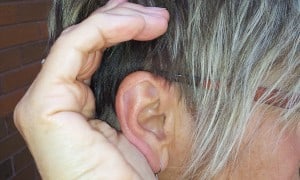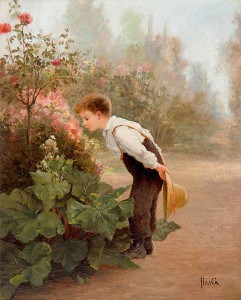“How sense-lucious the world is.”
– Diane Ackerman
In this second article on how to use our five senses to more fully experience the natural world, I am presenting some simple activities that can add an element of fun to any nature outing. These activities, which can be done alone, with your family or with a larger group, have been taken from an up-coming book I am co-writing with Jacob Rodenburg, Executive Director of Camp Kawartha, on seasons-based nature activities for kids.
Sight
As Diane Ackerman wrote in her national bestseller, “A Natural History of the Senses”, our eyes are the great monopolists of our senses. In other words, it is primarily through our eyes that we experience the world. Here are three fun activities to boost our ability to really see the natural world around us.
• Rainbow Colors: Go to a paint store and ask for paint chips (small cardboard pieces each with a different shade of colour) to take along on your next outing. Try to find natural objects along the trail that match the colour of the paint chips exactly. Once you start looking closely, you will be amazed at how many colours there are in nature. To make the game even more challenging, look for different shades of each colour – especially green.
• Look-Alikes – Look for objects or patterns in nature that remind you of something else (e.g., a pattern in the bark looks like a human face). Study the palm of one of your hands. Reach up under a tree and try to find a branching pattern that exactly matches the wrinkle pattern in your lower palm. How many examples can you find?
• The Human Camera: This is an activity for a group of children. You will need coloured pencils as well as pieces of stock paper or cardboard of about 4″ X 6″. Working in pairs, partner A (the human camera) closes his or her eyes. Partner B (the photographer) leads partner A to an interesting, close-up scene such as wildflower or a mushroom and positions the “camera” to get the best view. Partner B then pulls gently on partner A’s ear lobes to “open the shutter”, namely his or her eyes. Partner A stares at the scene for 30 seconds or so, remaining perfectly still. Partner B then says to Partner A “take a picture in your mind of what you see and then close your eyes once again.” Partner B carefully leads partner A back to a central location. Without the photographers watching and using the crayons and paper provided, the human cameras must now draw the scene they just took with their eyes and their mind. Now, put all of the “photos” on display. Can the photographers identify their scene? Switch roles and try the activity again.
Sound
From the buzzing of bees to the trilling of toads, every natural area is characterized by a unique soundscape. Recognizing the common bird, frog and insect songs not only provides a great deal of satisfaction, but it also avoids the hard work of having to actually see the animals each time to identify them. Like acquiring a new language, however, learning to listen to our nonhuman neighbours takes some effort and a little patience.
• Sound Maps – Find a comfortable place to sit for a few minutes, preferably out of talking range of another person. Place an “X” in the middle of a sheet of paper to represent your location. Each time you hear a sound, mark it on the sheet, showing its approximate location. Name the sound if you can or simply draw a picture or write down a few words to describe it (e.g., a little horn if the bird had a horn-like call). Afterwards, discuss what you heard with the rest of the group (e.g., natural sounds, human-made sounds, something you had never heard before, etc.)
• Focused Hearing: Squeeze your fingers together, take your two hands and cup them behind your ears. At the same time, gently, push your ears forward. This simple procedure can increase your hearing by up to 10 times. In a way, your ears have become “deer ears” – large parabolic dishes that capture sound waves.
• Contrast Walk – Block out all sounds by plugging your ears with your fingers as you walk about 50 metres. Stop, and without saying a word, heighten your sense of hearing by slipping on your deer ears. With ears cupped, turn towards different sounds you hear as you walk another 50 metres or so without talking. Discuss the contrast.
Smell
From the smell of the damp earth and abundant blossoms in spring to the spicy fragrance of fallen leaves in autumn, each season has its signature scents. When you are out for a walk or hike, get into the habit of smelling flowers, buds, green leaves and needles, conifer sap, etc. By gently rubbing plant parts, more of the chemicals they contain are released, which greatly increases the smell. In addition, take the time to think about how certain smells make you feel. The nerves that sense smell are directly connected to the emotional part of your brain, making smell a strong trigger for a flood of emotions.
• Lick, Rub and Sniff – Next time you go for a walk and want to smell something, try licking your upper lip. As with dogs and their cold, wet nose, wetness under the nose helps to distinguish more odours. Try a little “rub and sniff.” See if you can notice a difference between smelling with your upper lip dry and then again with it wet.
• Smell Cocktail: You will need some Dixie cups and small twigs. As you hike, encourage everyone to selectively harvest tiny “bits” of the forest and place them in the cup: a small pinch of leaf mould, a part of a rubbed leaf, etc. When you have a four or five items, stir them with your twig. This is your smell cocktail! Give each creation a name – perhaps “petaltopia” and let everyone smell each other’s concoction. Can you identify the smells?
Touch
When you are out on a walk, or just in the backyard, take a moment to think about what you are feeling – not just with your hands, but with your entire body. Feel the breeze, the warmth of the sun and the coolness of the shade. Run your fingers over the bark and leaves of different kinds of trees and notice how different they are. Compare, for example, the texture of oak leaves (thick and leathery) to those of maples (thin and more fragile).
• Barefoot Walk: Take off your shoes and socks and, wearing a blindfold, have a friend guide you as walk across a lawn with patches of sun and shade or through shallow water with a sandy bottom – anywhere that is safe and free of sharp objects. Change roles. Talk about how the temperature and the texture of the ground changed.
• Meet a Tree: This wonderful activity works best in an open area with lots of trees. You will need one blindfold for every two people. To demonstrate, blindfold a volunteer and say, “I’m going to introduce you to a special friend.” Gently and carefully guide the person in a circuitous route to a pre-selected tree – preferably one that isn’t too big. Have him or her feel the texture of the bark, the arrangement of low branches, the shape of the leaves, the girth of trunk, etc. The more tactile clues you offer, the better. Now guide the volunteer back to the starting point – but not the same way. Gently spin him or her around a few times and remove the blindfold. Say, “Can you find your tree?” Often this is easier said than done. Now, let everyone try it.
• Simple challenges: While walking through the woods, challenge group members to find objects in nature that really awaken our sense of touch. To get started, these could include the smoothest, roughest, softest, furriest, bumpiest, slimiest, spikiest, warmest and coldest!
Taste
Introduce kids – and maybe yourself, too – to the edible wild and the wonderful tastes to be experienced from the landscape. Some plants with edible leaves (generally the young leaves taste best) and flowers include Chicory, Dandelion, Fireweed, Wood Sorrel and all of the different violets. A delightful and familiar-tasting breath freshener can be had by chewing on a leaf or berry of Wintergreen. Simply spit it out when the taste starts to fade. WARNING! As always, be sure you absolutely know what you are tasting.
• Forest Tea: As you walk, harvest a handful of Eastern White Cedar and White Pine (long soft needles in bunches of 5). When you get home, toss these in boiling water and let steep for at least 10 minutes. The resulting tea will be bitter but refreshing, and your tongue will dance with the evocative taste of the forest!


